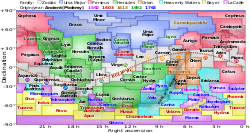Ecliptic

The ecliptic is the plane of Earth's orbit around the Sun.[1][2][3]
The Sun appears to move against the background of stars because the Earth orbits the Sun.
The invariable plane is the average plane of the orbits of the planets. Properly, it is defined as the plane passing through its barycenter (center of mass). The present ecliptic plane is inclined to the invariable plane by about 1.5°.
Ecliptic Media
The apparent motion of the Sun along the ecliptic (red) as seen on the inside of the celestial sphere. Ecliptic coordinates appear in (red). The celestial equator (blue) and the equatorial coordinates (blue), being inclined to the ecliptic, appear to wobble as the Sun advances.
Inclination of the ecliptic over 200,000 years, from Dziobek (1892). This is the inclination to the ecliptic of 101,800 CE. Note that the ecliptic rotates by only about 7° during this time, whereas the celestial equator makes several complete cycles around the ecliptic. The ecliptic is a relatively stable reference compared to the celestial equator.
References
- ↑ United States Naval Observatory Nautical Almanac Office; UK Hydrographic Office, HM Nautical Almanac Office (2008). The Astronomical Almanac for the Year 2010. United States Government Publishing Office. p. M5. ISBN 978-0-7077-4082-9.
- ↑ "LEVEL 5 Lexicon and Glossary of Terms".
- ↑ "The Ecliptic: the Sun's annual path on the Celestial Sphere".






